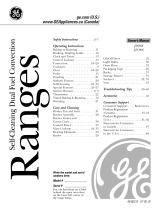
18
49-85214-3
Be sure electrical power is off and all surfaces are cool before cleaning any part of the oven.
Control Panel and Knobs
Wipe the control panel after each use of the oven with
a damp cloth. For cleaning, use mild soap and water or
a 50/50 solution of vinegar and water. Rinse with clean
water. Polish dry with a soft cloth.
Do not use abrasive cleansers, strong liquid cleansers,
plastic scouring pads or oven cleaners on the control
panel—they will damage the finish.
Do not try to bend knobs by pulling them up or down or
by hanging a towel or other such loads. This can damage
the gas valve shaft.
The control knobs may be removed for easier cleaning.
With knobs in the OFF position pull them straight off the
stems.
The knobs can be washed by hand with soap and water
or in a dishwasher.
Not all knobs are interchangeable. To determine the
correct location of a particular knob, examine the back of
the knob. A knob with a label or two stem holes should
be replaced on the front panel first by matching the
shape of the knob holes to the shape of the control panel
stems. The remainder of the knobs having no labels and
only one stem hole can then be replaced on the front
panel anywhere there is a single stem.
Oven Exterior and Cooktop Surface
Do not use oven cleaners, abrasive cleansers, strong
liquid cleansers, steel wool, plastic scouring pads, or
cleaning powders on the interior or exterior of the oven.
Clean with a mild soap and water or a 50/50 solution of
vinegar and water. Rinse with clean water and dry with a
soft cloth. When cleaning surfaces, make sure that they
are at room temperature and not in direct sunlight.
If a stain on the door vent trim is persistent, use a mild
abrasive cleaner and a sponge-scrubber for best results.
Spillage of marinades, fruit juices, tomato sauces and
basting liquids containing acids may cause discoloration
and should be wiped up immediately. Let hot surfaces
cool, then clean and rinse.
Oven Interior
The interior of your new oven can be cleaned manually
or by using the Steam Clean or Self Clean modes.
Spillage of marinades, fruit juices, tomato sauces and
basting liquids containing acids may cause discoloration
and should be wiped up as soon as hot surfaces cool,
then clean and rinse.
Manual Cleaning
Do not use oven cleaners, abrasive cleaners, strong
liquid cleansers, steel wool, scouring pads, or cleaning
powders on the interior of the oven. Clean with a mild
soap and water or 50/50 solution of vinegar and water.
Rinse with clean water and dry with a soft cloth. When
cleaning surfaces, make sure that they are at room
temperature and not in direct sunlight.
Steam Clean Mode (on some models)
The Steam Clean feature is intended to use water to
clean light soil from your oven at a lower temperature
than Self Clean.
To use the Steam Clean feature:
1. Start with the oven at room temperature
2. Wipe excess grease and soils from the oven
3. Pour one cup of water onto the bottom of the oven
4. Close and latch the door
5. Press the Steam Clean pad and then press Start.
The oven door will lock. You cannot open the door during
the 30 minute Steam Clean cycle as this will decrease
the cleaning performance. At the end of the Steam
Clean cycle the door will unlock. With a sponge, soak up
remaining water and wipe the moisture-softened soil from
the oven walls and door.
Stainless Steel Surfaces (on some models)
Do not use a steel wool pad; it will scratch the surface.
To clean the stainless steel surface, use warm sudsy
water or a stainless steel cleaner or polish. Always wipe
the surface in the direction of the grain. Follow the cleaner
instructions for cleaning the stainless steel surface.
To inquire about purchasing cleaning products including
stainless steel appliance cleaner or polish read the
Assistance and Accessories sections at the beginning of
this manual.
Stem
Label
Stem
holes
Surface burner knob Knobs with two stem holes have
special locations
Cleaning The Oven
CARE AND CLEANING: Cleaning The Oven





















